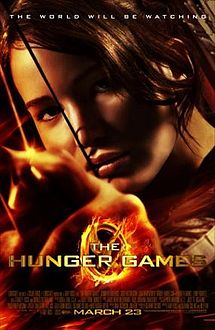THE FUTURE AS PAST
The Hunger Games will sap up comparisons to science fiction – that’s what happens with stories about futuristic dystopias and freaky hovercraft – but the better comparison is to Roman or Biblical epics of the fifties. Its story – of the teenagers of 12 outlying provinces exploited for the bloodsport of a wealthy and perverse capital – is reminiscent of Ben Hur or Spartacus. It even has a grand chariot parade, with crowds adoring Katniss Everdeen, a firelit, coal-haired Cleopatra.
These are essentially stories of the risks of opulence and how wealthy societies are built on this sort of cruelty and exploitation. Violent spectacle is seen as the dark payment for a vital but oppressive society. The suggestion is that civilization is little more than a sophisticated decoration of the primitive instinct.
Science fiction typically presents itself as the future, when really it is the present in disguise. But The Hunger Games begins by looking into the past. This is a future that first takes shape in a dim Appalachia, lingering in a permanent time warp, where even a nuclear war seems unable to change much. The coal shaft explosions are still as present as the class struggles that have marked the place for hundreds of years.
The is the world of Katniss Everdeen, and it bears considerable resemblance to the world of Ree Dolly, Jennifer Lawrence’s previous heroine from Winter’s Bone. In each film, she has played a backwoods teenager breadwinner with a missing father and an enfeebled mother. Lawrence seems to win these roles, at least in part, because her mild Kentucky accent is Hollywood’s idea of backwoods credibility. That she fills each truthseeker with the same blend of bravery and vulnerability is the cinema’s good fortune.
Katniss volunteers to take the place of her younger sister, who is chosen by lottery to participate in the annual Hunger Games, a 24-teen televised fight-to-the-death. By some twist of logic, this ceremony keeps the unruly districts from rebelling against the kleptocratic capital.
The story catches Katniss in two swirls – her impending fame and her impending death. From the latter, we arrive at a young woman revealing her sturdy character as she faces her demise. For the latter, our bow-and-arrow tomboy receives a makeover into a young woman. There’s a moment when the coal-country girl, partial to hunting clothing, goes for a twirl in front of a TV audience in a stylish dress. It’s a moment of surprise exhilaration, and it’s one of the film’s unexpected best moments. One of the shortcomings is that it loses sight of the fact that it is a coming-of-age story set in bizarre circumstances.
Coming-of-age means romance, as do Young Adult novels (the film is based on a book series by Suzanne Collins). A movie aimed at young women means “torn between two men.” So of course it includes a love story, with the wimpy but likable Peeta, a fellow contestant from her district. The dreamboat Gale sits this one out back home, leaving a triangle for future films. The suggestion is that the refreshment of purity, authenticity, and youth poses the greatest challenge to corruption.
Much has been wondered about the film’s politics. Are they left or are they right? Such is the state of politics in this country that the populist impulse on either side has come to resemble one another in some ways. The orientation is less important than their accuracy, of a centralized power structure draining the life and wealth out of the rest of the country, and the society that sublimates its violent imagination into competitive rituals.
But does The Hunger Games get this right? Or is this a case of authors overestimating ominous portents found in simple progress? In some ways, The Hunger Games is its own best evidence. Twenty years ago, a movie about a teenage murder pageant – aimed at teenage girls, no less – would have caused protestors to lay in front of the theater doors. Now it’s a girls night family outing.
On the other hand, we’re 20 years past The Running Man, which was the last time that we were “only a few years away” from this sort of thing. Somehow we’ve managed to steer clear of death match game shows. In reality, masculine excess is not our problem. Men being forced by wives to wear those embarrassing strap-on baby carriers is more our problem than excessive bloodlust. Sometimes I wish I lived in a country that could still stage a televised death match.
Anyway, although it drags at times, The Hunger Games is fairly enjoyable fare. And I’m also pleased to have a genuine event movie that everyone has seen, the first of several this year. Even better, its soundtrack hit No. 1 this week, something that used to be routine. It’s like taking a step back, appropriately, to 1984.
The Hunger Games
rated PG-13
now playing worldwide

